After about 27 hours on the road – most of that actually in one bus or another – we arrived in Piriápolis, making this our longest “travel day” yet on the trip. Our bus departed from Puerto Iguazú at 5:45PM, and took us overnight to arrive at Concordia at 6:30AM. This sounded like a pretty good itinerary on paper, but there were a couple of problems. This ride was not nearly so comfortable as our previous overnight bus. The food wasn’t nearly as good, the seats were toward the middle of the vehicle instead of in the front row, and the “in-flight” entertainment was broken. The second issue was our arrival location, which was beneath an overpass in the middle of the highway and nowhere near town. Christina and I disembarked along with half a dozen other backpackers, and none of us was quite sure what to do. We attempted to flag down a few passing buses loaded with what looked like work crews from town, but they were all heading away from Concordia and we were getting mixed information (from those who bothered to shout out the window at us) regarding whether we could expect local buses or taxis to make an appearance. We started walking in to town as a group, but Christina and I turned around to either wait for a bus or taxi, or to take our chances hitchhiking as a couple rather than as part of a large group. I had a fantasy about us leaning up against our packs in the back of a dirty gaucho truck and riding all the way across Uruguay to the coast. In the end what we got was a compromise, when we flagged down one of the crew buses, returning to town empty.
Christina engaged the driver in an exchange that went something like:
Christina: “Concordia?” [smile]
Driver: “Si…” [points down the road in the direction of town]
Christina: “Concordia?” [smile, point at us then at him]
Driver: “No”
Christina: “Concordia? Yo? Usted?” [smile, point at us then at him]
Driver: “No”
Christina: “Concordia? Por favor?” [smile]
Driver: “… si.” [smile]
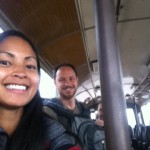
And we were on our way!
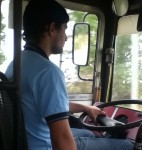
We understood from the driver that he wasn’t actually taking us in to town, but would get us close enough to make our own way. As we approached the group of other backpackers, still on the hoof, we asked him to let them board as well, and he pulled over. A short drive later (but probably at least a few hours by foot) he deposited our group at the side of the road near the first traffic light in Concordia, with instructions on which local bus would get us to the terminal.
Christina and I, along with a couple of German fellows took bus #2 bound for the terminal, and the rest of the group parted ways with us on bus #7 headed in to Concordia city center. Our two companions had much better Spanish skills than we did, which was very helpful. My plan had been to attempt to reach the coast without going through Montevideo (the main transport hub), but at the ticketing office the old guy acting as agent was clear enough for even my limited vocabulary. “Mas eficiente, mas práctico” while pointing at the highlighted route through Montevideo; “Mas mas deniero, mucho tiempo” goes for the rest of the country.
Five hours later we were in Montevideo, scarfing down some McDonalds before our next departure to Piriápolis. Our arrival was dark (because it was 9:30pm) and rainy. We had no accomodations lined up, but the cheapest thing in town also happened to be the closest to the station, and on a day like this that was all we needed to know. We checked in to the spartan yet servicable Hostel Piriápolis, and immediately hit the sack.
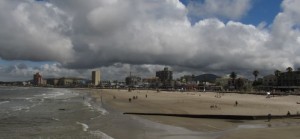
The morning came overcast and gloomy, but we were cheered to find our friends, Matas, Holly, and Anna, all from Eco Yoga Park, having breakfast in the dining lounge. It was not a complete surprise, since we had been in some contact with them and knew that they were staying here, but expected or not, they still made for a very welcome sight.

We spent the day walking around town with them and swapping tales of our adventures in the week or so since we had last parted.
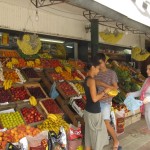
In the evening we cooked dinner together – spaghetti with a home-made sauce recipe out of the folks’ book, and bruschetta.

The food and company were both great; we sat around chatting for a few hours, and put away nearly a bottle of wine each before bed.
Our next day was a bit more promising, weather-wise. Around lunch it started to finally clear up, and showed us a very nice afternoon. Christina and I took advantage, and walked through town again, stopping this time at La Goleta, a restaurant along the boardwalk, for a lunch of pizza and sangria.
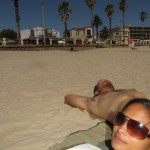
Digestion was aided by some time on the beach, which has very nice white sand, but no waves to speak of. Our group (plus Oz, a friend of theirs met in Peru, and recently arrived at our hostel) shared another evening meal, this time of fajitas, with an attempt at home made salsa, with some success, though I would prefer more caliente.
Christina had been in negotiation with a person in Punta del Diablo, a very small village further north, for the rental of a suite, and we headed off the next morning. We skipped the scanty breakfast served at the hostel to make a last minute ATM run, since Punta del Diablo is so small that it’s single ATM runs only during the highest of high season, and is notoriously short of bills. This town was recommended to us by some folks we had met at Eco, and in my readings online it sounded like a perfect little beach/surf spot to spent a week or two.
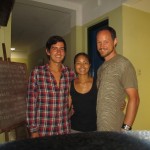
After a quick “goodbye” to our friends, well mostly Matas, who was up early, we packed up our gear and walked to the bus terminal. Somewhat amusingly, the bus we boarded did a full lap around town, and actually stopped right in front of our hostel, before heading north to Pan de Azucar, a nearby town where we would make a connection. There we bought a ticket for the next ride to Punta del Diablo, and waited the hour before departure on the sidewalk, since there wasn’t so much as a coffee shop to pass the time. Finally our bus pulled up and we boarded, taking what were apparently the last two seats.
It was a four hour ride, and gave us lots of time to reflect on Uruguay, which has been more affluent and friendly than expected. We will be spending our first “warm” Christmas here, in a tiny village, and will need to really try to imagine the festive season that we are used to.